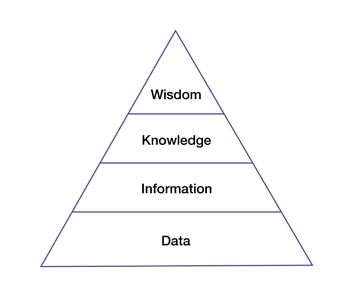When we talk of data-driven manufacturers, we speak of manufacturers that demonstrate several common attributes. They act preemptively, have highly productive teams, operate with a level of resilience and agility that sees them through uncertain times, and have a track record of consistently meeting their KPIs. The combination of these attributes paints a picture of organizations that are “astute” and “wise,” or in a more technology world term, they have unleashed enterprise intelligence.
Enterprise intelligence is foundational to becoming a truly data-driven organization. It refers to the collection, analysis and dissemination of data and information within an organization to support informed decision-making. But how can you harness it?
Move up the knowledge pyramid
The knowledge or DIKW (data, information, knowledge, wisdom) pyramid is a framework that represents the hierarchy of information, how it evolves as more context and meaning are integrated, and the roles the various types of information play. While there are a few models, in general, the pyramid has four key levels:
- Data: raw, unstructured information that has not been processed or analyzed.
- Information: data that has been processed and organized into a meaningful structure, such as reports or visualizations.
- Knowledge: information that has been analyzed, interpreted and applied to a specific context.
- Wisdom: the ability to apply knowledge and make informed decisions based on it.
The key to becoming data-driven is understanding where your organization figures in the pyramid. It’s likely that different business units and manufacturing processes will be at different levels, and that is okay. What’s important is understanding at which level you need to be to achieve your business goals.
In general, the application of analytics, machine learning and AI can help manufacturers move up the pyramid. Let’s take the example of tracking sales. If a company is at the “data” level, they will likely have a spreadsheet or perhaps a database that tracks and records sales, which is shared with those who need to review it. A lot of the end work rests with the receiver. At the “information” level, the receiver might get a standard report that summarizes sales. As we move up the pyramid to “knowledge,” business intelligence programs will likely be applied to track stock levels and recommend pricing. Ordering may also be automated. Finally, at the top, “wisdom” takes into account multiple data streams to make even more informed suggestions, such as checking stock prices, analyzing buying patterns, tracking social media, etc.
Applying enterprise intelligence to advance transformation
The opportunities for using enterprise intelligence, i.e., the right data, at the right time, in the right format, to support manufacturing, are numerous. Here are a few use cases:
- Predictive maintenance: Using machine learning algorithms to analyze equipment data and predict when maintenance is required, reducing downtime and maintenance costs.
- Quality control: Analyzing data from production processes to detect and prevent quality issues, improving product quality and customer satisfaction.
- Supply chain optimization: Analyzing data from suppliers, production processes and customers to optimize the supply chain, reducing costs and improving delivery times.
- Inventory management: Using sales, production and supplier data to optimize inventory levels, reducing waste and increasing efficiency.
- Energy management: Analyzing energy consumption data to identify and implement energy-saving measures, reducing costs and improving sustainability.
- Production planning and scheduling: Using data from production processes, demand forecasts and capacity data to optimize production planning and scheduling, reducing waste and increasing efficiency.
- Employee performance management: Analyzing data from employee performance to identify areas for improvement and provide training and support, improving employee satisfaction and productivity.
But where do you start?
Determine the right use cases to unlock the potential of data
There are many problem spaces within manufacturing that becoming data-driven can help solve, but knowing where to start can be tricky. Here are five steps to begin the process.
- Start by identifying the business objectives you want to achieve with your data, be it improving customer satisfaction, reducing costs or increasing efficiency. Ensure you talk to your employees on the ground to understand what holds them back from working more efficiently and what ‘quick wins’ will bring business value. Gaining a 360-degree view of the organization is vital.
- Take a close look at the data you already have. Determine what data is available, how it is currently being used, and what additional data you need to support the business objectives you’ve identified.
- Based on your business objectives and the available data, pinpoint the potential use cases for your data. Consider how you can use your data to support decision-making, automate processes and drive innovation. Evaluate each potential use case to determine its feasibility and possible impact. Consider factors such as the cost of implementation, the resources required and the expected return on investment.
- Now, prioritize the use cases that have the greatest potential impact and that best align with your business objectives. Review the market for suitable products and solutions aligned with those goals.
- Implement the prioritized use cases and continuously monitor and measure their impact. Use the results of these measurements to adjust the use cases as needed.
Supported by the right data strategy, data governance and organizational readiness, enterprise intelligence has the power to turn context-relevant data into actionable insight to support change and help you achieve your strategic vision.
Get in touch with me to learn how we are helping leading manufacturers worldwide implement and roll out enterprise intelligence programs.
Blog series
4 steps to become a data-driven manufacturer.
Are you asking the right questions to build your manufacturing data strategy?
Data management in manufacturing: the difference between being data-driven and data-burdened.
Why taking a people-first approach is critical to becoming a data-driven manufacturer.







